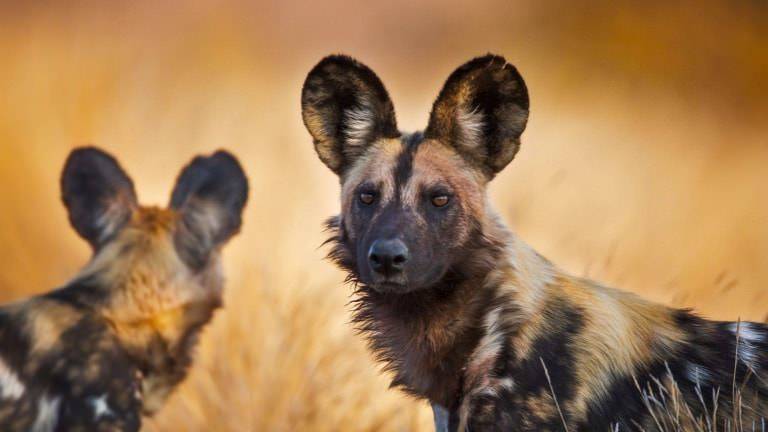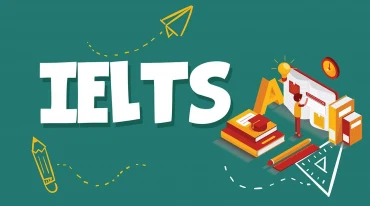
- 357 Lê Hồng Phong, P.2, Q.10, TP.HCM
- Hotline 1: 1900 7060
Hotline 2: (028) 3622 8849
Bài tập IELTS Reading - On the trail of Africa’s wild dogs

Just before dawn at a National Park in North Eastern South Africa, Micaela Szykman stands on a hill with a radio transmitter held in the air, listening for signals from the radio collars of African wild dogs. If the dogs are within range, Szykman jumps back into her four-wheel drive to catch up with them before they awake. Szykman, a researcher at the Smithsonian National Animal Park in Washington, D.C., is tracking the dogs for a park project.
The African wild dog, officially named Lycaon pictus, and also called the painted wolf or the Cape hunting dog is the victim mainly of human hunting. The dog is listed as endangered by the World Conservation Union. Lycaon pictus once roamed most of sub-Saharan Africa. Now only about 5,000 dogs can be found in isolated pockets of the continent.
In 1997, 2000, and 2003, wildlife managers reintroduced several packs of wild dogs from elsewhere in South Africa to this park in the hope of rebuilding the species. Wildlife officials and scientists like Szykman are watching and studying the reintroduction because such programs are integral to Lycaon’s survival.
Adult wild dogs, with round saucer-like ears and a “painted” black, white, brown, and yellow coat, weigh up to 25 kilograms and stand about 60 centimetres with a delicate build. “This is one of the most intensely social animals out there,” said Szykman, a behavioural scientist. “The entire pack, sometimes up to 20 dogs, always hunts, plays, walks, and feeds together. They never leave an animal behind and are always strengthening social bonds.” Each pack has only one breeding pair, and the rest of the pack helps raise the annual litter, up to 20 pups, one of the largest litter sizes of all African animals. Lycaon pictus hunts in packs and Szykman’s job is particularly difficult because wild dogs are tough to track. They travel up to 30 kilometres daily, with vast home ranges, 600 to 800 square kilometres on average.
“As a discipline, the science of reintroduction has been poorly studied,” said Steven Monfort, a research veterinarian at the Conservation and Research Centre in Front Royal, Virginia. “Reintroduction is not easy. Governments set aside land, and other people dump animals in there, which makes them feel good. If the animals increase, the reintroduction is a big success. If numbers fall nobody knows what went wrong,” Monfort said. The dogs’ radio collars provide only limited contact. Monfort has proposed the development of a satellite-tagging system so that Szykman and Monfort can track the animals year-round and mark their range, including how close they come to humans and other threats.
The researchers also hope to expand the use of satellite collars to hyenas and lions to understand how competition with these animals affects the dogs’ reproduction and survival. These two species also play a role in reducing African wild dog numbers. “If you fence in a reserve or surround a wild area with human settlement then you need to adjust the species levels to maintain healthy populations of dogs, hyenas, and lions which are all interacting on overlapping areas of land,” said Monfort.
To Scott Creel, a behavioural scientist at Montana State University in Bozeman, reintroduction is the right approach for South Africa. “Reintroduction is exciting because it beats caged management in zoos. But in the long term, it is useless unless it results in larger, well-protected reserves or changes patterns of land use. These wild dog populations won’t be self sustaining unless the land area is large enough” said Creel, co-author of The African Wild Dog: Behaviour, Ecology and Conservation. “There’s a long history of reintroduction there. They have a good idea of what works and what doesn’t.”
Hunting drastically reduced the wild dog population in South Africa except for Kruger National Park where there are approximately 300 to 500 dogs. Though Creel is also not convinced that the reintroduced wild dog population will thrive without hands-on management, he supports the effort because reintroduction of these animals at smaller satellite parks and private reserves raises the national wild dog population and is an insurance policy if disease hits. Already the luck of African wild dogs is changing. In the past, farmers often just shot the dogs on sight. Now when somebody sees the dogs outside the reserve, Szykman gets a call about their location.
Do the following statements agree with claims of the writer in Reading Passage 3?
In boxes 27-32 on your answer sheet, write
YES if the statement agrees with the claims of the writer
NO if the statement contradicts the claims of the writer
NOT GIVEN if it is impossible to say what the writer thinks about this
27 The African wild dog has other names associated with it, often being referred to as the ‘hunting wolf’.
28 There are more African wild dogs in Sub-Saharan African than in South Africa.
29 Scientists are trying to save the African wild dog by putting them in new national parks in South Africa.
30 African wild dogs roam large areas and often travel extreme distances
31 Introducing African wild dogs into new areas is quite easy and there has been a lot of research related to this field.
32 Radio transmitters help scientist track the movements of hyenas and lions.
Choose THREE letters A-G
Write the correct letter A-G, in boxes 33-35 on your answer sheet.
Which THREE of the following are given as reasons for African wild dogs currently being endangered?
A Doing scientific tests on the wild dogs.
B The loss of habitat for the dogs.
C The building of fences to capture them.
D Hyenas and lions competing with them.
E Transporting the dogs to other areas.
F Not having enough food to eat.
G Humans killing wild dogs.
Look at the statements (Questions 36-40) and the list of scientists and researches below.
Match each statement with the correct person, A-C.
Write the correct letter, A-C, in boxes 36-40 on your answer sheet.
NB You may use some letters more than once.
This scientist or researcher…
36 is monitoring the African wild dogs’ movement and behaviour.
37 has found that African wild dogs are a family orientated species.
38 does not think current systems of tracking African wild dogs is sufficient.
39 believes repopulating areas with African wild dogs is currently the best solution for their survival.
40 thinks that local attitude towards African wild dogs is changing in a positive way.
List of People
A Micaela Szykman
B Steven Monfort
C Scott Creel
PHÂN TÍCH TỪ VỰNG:
Dawn /dɑːn/ (n): bình minh (the period the sun begins to appear in the sky)
A radio transmitter: máy phát sóng vô tuyến
Collar /ˈkɑː.lɚ/ (n): vòng cổ (a type of necklace)
Within range: ở trong tầm mắt
Isolated pocket: khu biệt lập
Rebuilding the species: cấy tạo giống nòi
Integral to: không thể thiếu với
Reintroduction: sự phóng sinh động vật
A delicate build: cơ thể mỏng manh
Social bonds: tính bầy đàn
Annual litter: các lứa theo năm
Vast home range: lãnh thổ rộng lớn
As a discipline: về mặt chuyên môn
Satellite-tagging system: hệ thống vệ tinh theo dõi
Year-round: quanh năm suốt tháng
Caged management: sự giam cầm, giam giữ
Hands-on management: giám sát thực tiễn
Private reserve: khu bảo tồn tư nhân
ANSWER KEY:
27. NO (Lycaon pictus, painted wolf and cape hunting dog) 28. NOT GIVEN 29. YES
30. YES 31. NO (difficult/ poorly researched) 32. NO (currently help track wild dogs)
33. B/D/G 34. B/D/G 35. B/D/G
36. A 37. A 38. B 39. C 40. A
THƯ VIỆN LIÊN QUAN

Reading là một trong bốn phần thi bắt buộc của bài thi IELTS, đây cũng được xem là phần thi thử thách nhất để chinh phục được band điểm cao. Hãy...

Bài viết cung cấp cho đọc giả Bài tập Reading part 3 - Chủ đề: Why fairy tales are really scary tales - Có đáp án

Bài viết cung cấp cho đọc giả Bài tập Reading part 2 - Chủ đề: The Desolenator: producing clean water - Có đáp án

Bài viết cung cấp cho đọc giả Bài tập Reading part 1 - Chủ đề: Henry Moore (1898-1986) - Có đáp án
Hoặc gọi ngay cho chúng tôi:
1900 7060
 | Chính sách bảo mật thông tin | Hình thức thanh toán | Quy định chung
| Chính sách bảo mật thông tin | Hình thức thanh toán | Quy định chung
Giấy chứng nhận đăng ký doanh nghiệp số 0310635296 do Sở Kế hoạch và Đầu tư TPHCM cấp.
Giấy Phép hoạt động trung tâm ngoại ngữ số 3068/QĐ-GDĐT-TC do Sở Giáo Dục và Đào Tạo TPHCM cấp